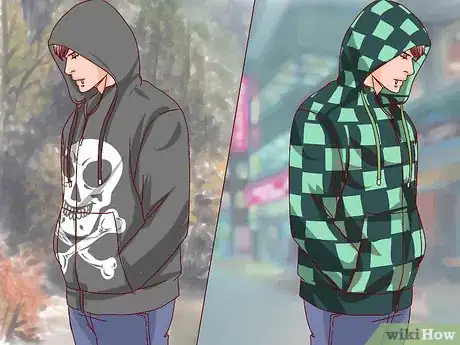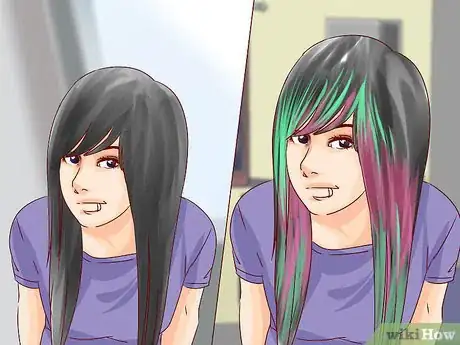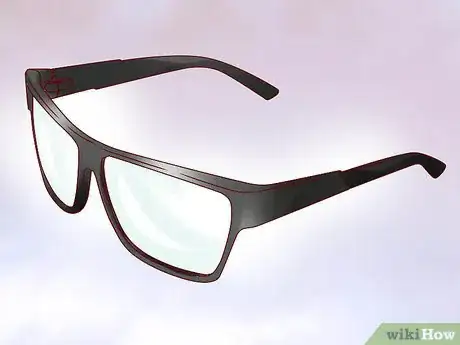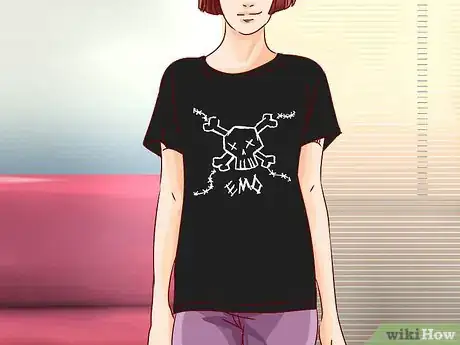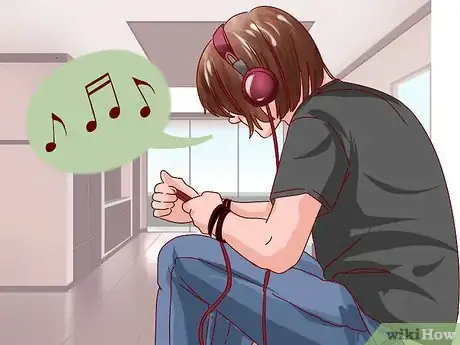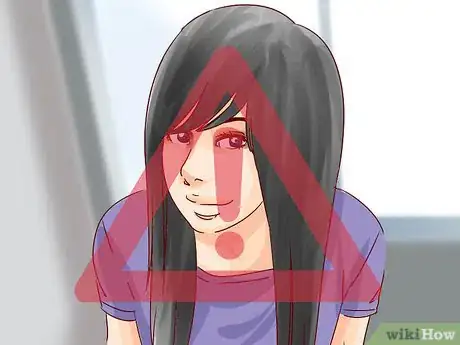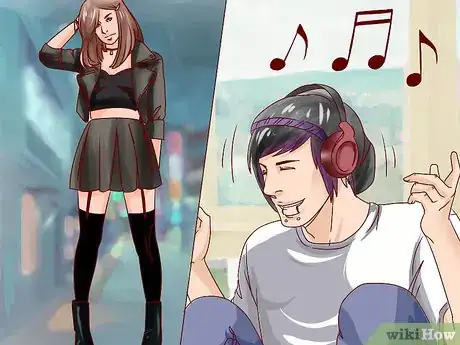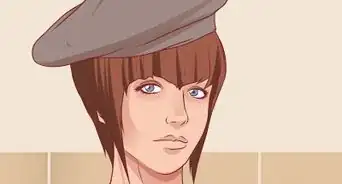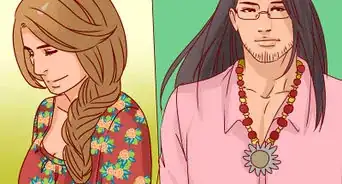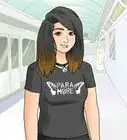This article was co-authored by Regina Dunn and by wikiHow staff writer, Amber Crain. Regina has been passionate about the goth subculture for over 10 years. She studied goth fashion and subculture in school and she has worked to fight misinformation and misappropriation about the goth subculture within the media. Regina is active in a range of online communities and wikis, continuing to educate and get exposure for goth music and subculture.
There are 11 references cited in this article, which can be found at the bottom of the page.
wikiHow marks an article as reader-approved once it receives enough positive feedback. In this case, 83% of readers who voted found the article helpful, earning it our reader-approved status.
This article has been viewed 225,564 times.
Emo and scene are two subcultures that are often confused with one another. Generally speaking, emo is a subculture rooted in a particular genre of music (punk and post-hardcore) whereas the scene culture is largely rooted in fashion and style choices. The confusion comes from a large amount of crossover between the two because of hairstyles and clothing. Identifying one subculture from the other can be challenging, but once you learn what details to look for, you’ll be able to recognize the differences instantly.
Steps
Distinguishing the Fashion
-
1Examine the color choices. Scene fashion emphasizes bright, often neon, colors.[1] By contrast, the most popular color choice in emo fashion is black.[2] Aside from the color choices, a lot of clothing between the two subcultures can look quite similar. Because of the similarities, scene kids are even occasionally referred to as neon-emos.[3]
- The number one goal of scene fashion is to call attention to the wearer, and neon colors are worn to that end.
- Scene also takes a lot of cues from anime influences, further pushing their over-the-top and colorful fashion sense.
- A zip-hoodie in a dark color is a crucial clothing item in emo fashion. The hoodie can be plain or be covered in icons characteristic of the emo culture, such as bleeding hearts, skulls, ribs, stars, and broken hearts.
- Scene fashion also champions hoodies, but they will generally be paired with neon drainpipe jeans.[4] Cartoon- and animal-printed hoodies are especially popular.[5]
- Scene fashion also includes cartoon- and animal-printed shirts, tutus, mismatched socks, mismatched leggings, and graphic band shirts.[6]
-
2Know the difference in hairstyles. The scene subculture’s love for neon colors sets them apart from the emo subculture when it comes to hair, as well, although the actual hairstyles themselves can look somewhat similar. The number one look for both cultures is based around a long fringe (bangs) brushed over to one side of the head, covering one or both eyes.[7]
- Emo hair is often dyed black, with stripes of color (usually bleached blond or blue) sometimes added in, and very straight.
- Emo silhouettes are thin, smooth and flat, occasionally featuring sharp angles and asymmetry. It is popular for the hair in front to be long, while the hair in the back is short.
- Scene hairstyles are exaggerated versions of the emo look, often dyed in a rainbow of neon colors, and backcombed to be bigger and fluffier.[8] [9]
- Hair extensions in bright colors or animal prints are prevalent, especially among scene girls.[10]
- Scene hairstyles often include choppy, layered, and teased hair, along with extensions and tiaras.[11]
Advertisement -
3Look for black horn-rimmed glasses. These are extremely popular in emo fashion for guys.[12] Emo has an undercurrent of "nerd" style running through it, and thick glasses with black frames are key accessories for both genders, but males especially.
- This nerd style undercurrent is not present in scene fashion at all.
- The popular choices in scene eyewear are brightly colored sunglasses with very large frames, sometimes referred to as party sunglasses or party shades.[13]
-
4Notice band t-shirts. Both subcultures have ties to music, but emo is far more music-centric than scene. In fact, as a subculture, emo was born out of a musical style with roots in the punk and post-hardcore genres.
- Scene, on the other hand, is usually viewed as a fashion trend or stylistic choice.
- Because of emo's powerful link to music, tight-fitting t-shirts featuring bands and band names are one of the most commonly seen clothing articles in emo fashion.
-
5Count the piercings and tattoos. Members of both subcultures tend to have piercings and tattoos, but they are far more prevalent and extensive within the scene culture. Scene kids will typically have multiple facial piercings and go for more drastic body modifications like ear gauges.
- Tattoos are popular in emo circles, with less emphasis on piercings.
- Tattoos of stars are considered emo, as well as “sleeves” (full arm tattoos that stop at the wrists).
Characterizing the Music
-
1Listen for a dance beat. The scene culture leans toward "party music" that you can dance to and is often electronic. The music is much more pop-oriented and makes great background noise for socializing and having a good time. Emo music, on the other hand, is not danceable, and is much more rock-centric.
- The typical emo sound is dramatic in its emotional range and often features a dynamic of alternating loud/soft extremes. It tends to emphasize emotion rather than socializing and partying.
- Fast, punk-derived drum beats and heavily distorted guitars are common elements in the emo sound.[14]
-
2Assess the vocal styles. Emo vocals are dramatic in mood and can even occasionally feature screams, moans, and howls. Lyrically, emo musicians are introspective and focus on emotional issues like sadness, confusion, love, anger, and pain.[15]
- Later emo musicians developed a slightly softer, more mainstream sound, but the lyrical content remained just as brooding and contemplative.
- Scene music does not put any particular emphasis on lyrical content and doesn’t feature the inward-looking, thoughtful vibe that is characteristic of emo.
-
3Know popular band names. Recognizing and listening to the “right” emo bands is a key component of emo culture. Bands are slightly less important in the fashion-centric scene culture, but there are some bands that are overwhelmingly considered to be “scene bands.”
- Some of the flagship bands in emo culture, both past and present, are: Rites of Spring, Embrace, Moss Icon, Drive Like Jehu, Fugazi, Jawbreaker, Sunny Day Real Estate, Dashboard Confessional, Jimmy Eat World, Get Up Kids, The Promise Ring, Brand New, My Chemical Romance and Fall Out Boy.[16]
- Scene band names to look out for are Blood on the Dancefloor, Owl City, Dot Dot Curve, Brokencyde, Scene Kidz, Millionaires, Jeffree Star and Hollywood Undead.
- Scene music also features a lot artists from electro-pop, dance-pop, dubstep, and house/techno genres. Names to recognize are Skrillex, Knife Party, and deadmau5. Occasionally, mainstream pop stars like Katy Perry and Nicki Minaj are also embraced by the scene subculture.
- Scene music also includes genres like crunkcore, metalcore, post-hardcore, and hip-hop/trap.[17]
Recognizing the Lifestyle
-
1Investigate online presence. The scene culture puts a lot of emphasis on online presence, especially via social media and networking platforms. This originated with Myspace and continues today on all social media platforms. Members of the scene culture will have friends and followers in excess and typically post profile images of themselves that are highly stylized. The details of their lives are often shared frequently via pictures and status updates, sometimes exhaustively.
- By contrast, emo culture is far more introverted. A social media presence is common, but the sharing isn’t excessive and friends and followers are usually obtained through connections through music and shared interests in particular bands.
- Online communities are frequently created by those of the emo culture, and they often use the internet to seek out other emos that they can connect to.[18]
- Emo posts and status updates are often cryptic and emotional.[19] Quoting song lyrics as a way to explain to the world how you feel inside is a common emo characteristic.
- Members of the emo community might use slang, spell words correctly, and style their usernames on social media a certain way. For instance, some users put "xX" at the beginning and end of their usernames.[20]
-
2Look for androgyny. The scene culture overwhelmingly embraces and celebrates gender-bending and androgyny. The approach is reminiscent of glam rock icons of the 1970s, such as David Bowie. Experimentation in sexuality is commonplace and the lines between genders are deliberately blurred. Feminine or androgynous looks are favored by all genders within scene culture, with little emphasis on masculinity.
- While the emo subculture in no way condemns androgyny, there is no emphasis on it at all. In fact, in the past emo has been criticized for being incredibly male-centric.
- This criticism is debatable, as all criticisms are, but the members of emo bands are predominantly male.
- However, there is no gender dominance among the fans of emo music, which appears to be enjoyed by all equally.
-
3Watch for a smile. While the stereotype is frequently overstated, there is a tendency among those who identify as emo to be emotional, sensitive, shy, introverted, withdrawn and even angsty. This stereotype originated in emo music, which often focuses on similar themes.[21] Because of the intimate connection to music that often characterizes an emo personality, these themes are often used to describe the general mood of the members of emo subculture. You are far more likely to see a smile on the face of someone who identifies as scene rather than emo.
- Scene culture focuses on fashion and socializing and, generally speaking, its members are more outgoing and friendlier than those of the emo culture.
- There is no particular emphasis placed on emotions in scene culture.[22]
- Emo culture is sometimes criticized for promoting self-harm, suicide, and death in general. This is exaggerated and largely incorrect.
- Emo culture's emphasis on emotion is often misinterpreted negatively by those outside of the culture.
-
4Note styles of self-expression. Members of the emo subculture tend to express themselves via poetry, art, and music. Scene culture communicates largely through fashion and their sense of style.[23]
- Emphasis is placed on visual communication and experimentation in scene culture.
- Emo culture, on the other hand, finds self-expression mostly through music, and to a lesser extent, other types of art.
Expert Q&A
-
QuestionHow do you know if you're emo or scene?
 Regina DunnRegina has been passionate about the goth subculture for over 10 years. She studied goth fashion and subculture in school and she has worked to fight misinformation and misappropriation about the goth subculture within the media. Regina is active in a range of online communities and wikis, continuing to educate and get exposure for goth music and subculture.
Regina DunnRegina has been passionate about the goth subculture for over 10 years. She studied goth fashion and subculture in school and she has worked to fight misinformation and misappropriation about the goth subculture within the media. Regina is active in a range of online communities and wikis, continuing to educate and get exposure for goth music and subculture.
Goth Subculture Enthusiast Remember that scene is better described as a fashion style which evolved from a range of styles, including emo pop, skater, pop punk, electronic, and crunkcore. There is no genre of music named “scene”, while "emo" is usually associated to different musical genres and sub-genres.
Remember that scene is better described as a fashion style which evolved from a range of styles, including emo pop, skater, pop punk, electronic, and crunkcore. There is no genre of music named “scene”, while "emo" is usually associated to different musical genres and sub-genres. -
QuestionAre "emo pop" and "scene" the same thing?
 Regina DunnRegina has been passionate about the goth subculture for over 10 years. She studied goth fashion and subculture in school and she has worked to fight misinformation and misappropriation about the goth subculture within the media. Regina is active in a range of online communities and wikis, continuing to educate and get exposure for goth music and subculture.
Regina DunnRegina has been passionate about the goth subculture for over 10 years. She studied goth fashion and subculture in school and she has worked to fight misinformation and misappropriation about the goth subculture within the media. Regina is active in a range of online communities and wikis, continuing to educate and get exposure for goth music and subculture.
Goth Subculture Enthusiast In my view, “emo pop” fashion is essentially scene. The main difference between them are the colors, given that people who tend to consider themselves emo or scene often listen to the same mix of bands.
In my view, “emo pop” fashion is essentially scene. The main difference between them are the colors, given that people who tend to consider themselves emo or scene often listen to the same mix of bands.
References
- ↑ Regina Dunn. Goth Subculture Enthusiast. Expert Interview. 12 July 2021.
- ↑ https://www.soemo.co.uk/emo%20fashion.php
- ↑ https://www.soemo.co.uk/scene-kids.php
- ↑ http://www.cosmopolitan.co.uk/entertainment/news/a40770/former-scene-kids-will-remember/
- ↑ Regina Dunn. Goth Subculture Enthusiast. Expert Interview. 12 July 2021.
- ↑ Regina Dunn. Goth Subculture Enthusiast. Expert Interview. 12 July 2021.
- ↑ https://www.soemo.co.uk/emo%20fashion.php
- ↑ http://www.cosmopolitan.co.uk/entertainment/news/a40770/former-scene-kids-will-remember/
- ↑ Regina Dunn. Goth Subculture Enthusiast. Expert Interview. 12 July 2021.
- ↑ http://www.differencebetween.net/miscellaneous/difference-between-emo-and-scene/
- ↑ Regina Dunn. Goth Subculture Enthusiast. Expert Interview. 12 July 2021.
- ↑ https://en.wikipedia.org/wiki/Emo
- ↑ https://www.soemo.co.uk/emo%20fashion.php
- ↑ http://www.fourfa.com/styles/index.htm
- ↑ https://www.soemo.co.uk/emo%20music.php
- ↑ https://www.soemo.co.uk/emo%20music.php
- ↑ Regina Dunn. Goth Subculture Enthusiast. Expert Interview. 12 July 2021.
- ↑ https://www.soemo.co.uk/emo%20lifestyle.php
- ↑ https://www.soemo.co.uk/emo%20lifestyle.php
- ↑ Regina Dunn. Goth Subculture Enthusiast. Expert Interview. 12 July 2021.
- ↑ http://www.fourfa.com/history.htm
- ↑ https://www.soemo.co.uk/scene-kids.php
- ↑ https://www.soemo.co.uk/scene-kids.php
About This Article
Although they overlap in some areas and are often confused with each other, there are differences between emo and scene. Emo people generally dress in band t-shirts and dark clothes, often with gothic imagery, while scene people wear bright and neon colors that draw attention to themselves. Emos often have black hair while scene fans generally have bright hair or colored highlights in dark hair. Emo music is more rock-based with distorted guitars and often features screaming, while scene music is usually upbeat with electronic instruments. Personality varies by person, but emos often present themselves as introverted and sensitive, while scene people act more lighthearted and fun. For more tips, including how to notice the difference between emos and scene kids on social media, read on!
